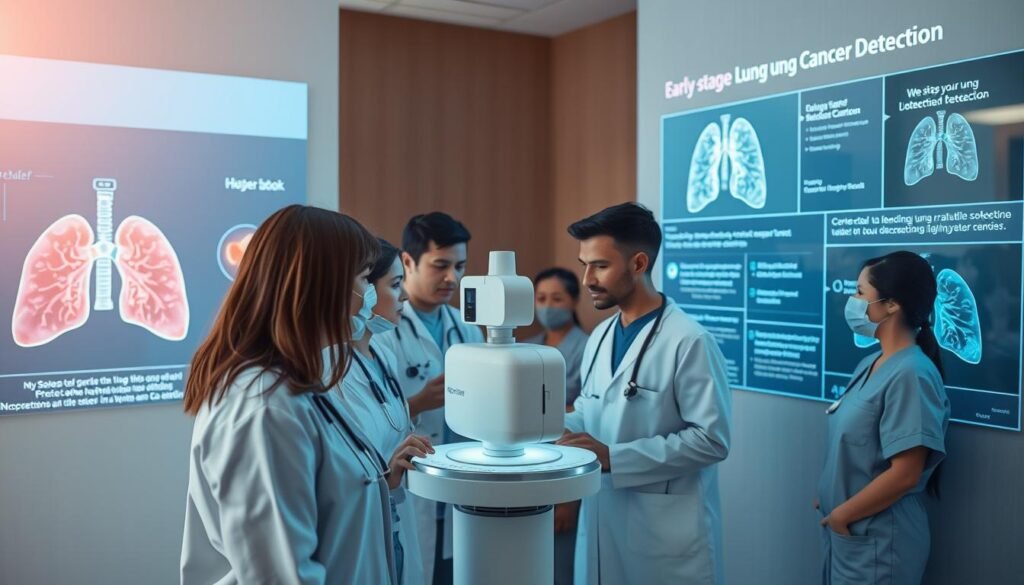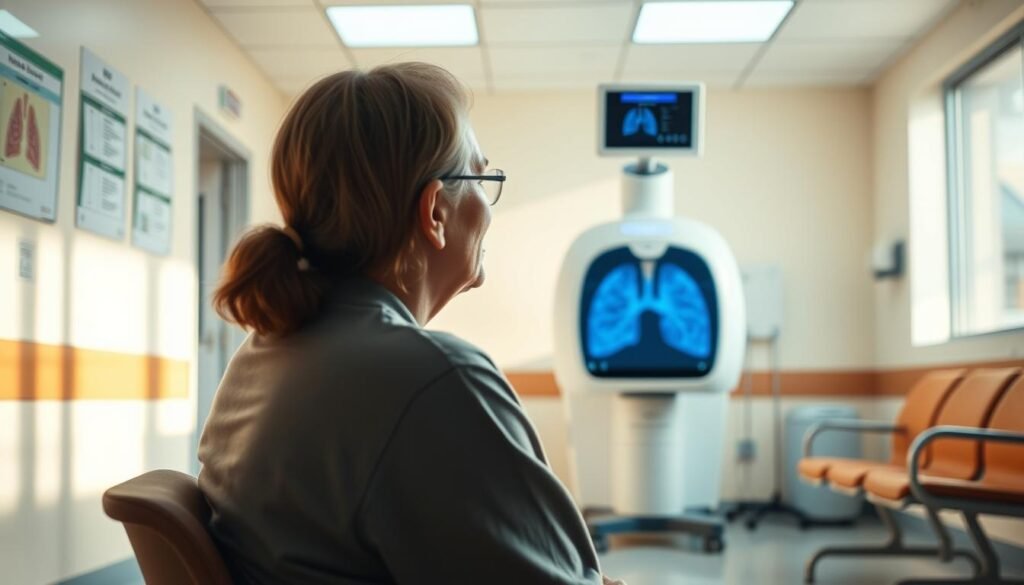In 2021, the U.S. saw over 209,500 new lung cancer cases. The disease claimed 131,888 lives by 2022. Yet, only 18% of those who should be screened get it done. Advocacy for early detection of lung cancer aims to change these scary numbers.
Raising awareness about lung cancer can save lives. It leads to early diagnosis and better treatment choices. Advocacy groups are working hard. They highlight the need for timely screenings to improve life quality for those suffering.
Key Takeaways
- Over 209,500 new lung cancer cases were reported in 2021 in the U.S.
- The death rate for lung cancer remains the highest among all cancer types in the country.
- Only 18% of eligible individuals in the U.S. are receiving the recommended lung cancer screenings.
- Screening with annual low-dose CT scans can reduce lung cancer death rates by up to 20%.
- Advocacy efforts are crucial in educating the public about the need for early detection for lung cancer.
Understanding Lung Cancer: An Overview
Lung cancer is a leading cause of death in the U.S. Knowing about it, including different types and how it grows, is key. This helps us spot risks and begin treatments early.
What is Lung Cancer?
Lung cancer has two main types: small cell lung cancer (SCLC) and non-small cell lung cancer (NSCLC). They grow and respond to treatment differently. It’s the top cancer killer, making early detection vital.
How Lung Cancer Develops
Lung cancer’s biggest risk comes from smoking, but it can also hit non-smokers. Things like radon or asbestos and genes also play a part. We need more awareness to spot it early and promote check-ups.
| Type | Characteristics |
|---|---|
| Small Cell Lung Cancer (SCLC) | Rapid growth, often metastasizes early. |
| Non-Small Cell Lung Cancer (NSCLC) | Slower growth, more common, various subtypes. |
Screening for lung cancer is thus essential. The American Cancer Society advises yearly checks for those 50 to 80 who’ve smoked a lot. Early-stage lung cancer can often be found with low-dose CT scans, improving chances of survival.
The Importance of Early Detection
Finding lung cancer early is key to better outcomes for patients. Knowing the survival rates helps show how vital this is. If caught early, nearly 60% of patients live five years or more.
However, early detection is rare, with less than one-quarter of cases found early. This shows why screening for lung cancer is so crucial to improve survival rates.
Survival Rates for Early Stage Lung Cancer
People with early-stage lung cancer have a much better chance of surviving. Data shows a five-year survival rate of about 22% overall. For men, it’s 18% and for women, 25%.
This difference highlights the need for better lung cancer screening methods.
Comparison with Other Cancers
Lung cancer screening is far behind that for breast or colorectal cancer. This needs to change to save more lives. We need to make people more aware and urge them to get screened early.
Lung cancer is the top killer among cancers. It causes more deaths than the next three cancer types combined.

Advocacy for Early Lung Cancer Detection
Lung cancer advocacy groups are key in raising awareness and better outcomes. They get communities involved in lung cancer support. Through programs from groups like LUNGevity, they push for early lung cancer detection. This helps to improve survival rates. They urge folks and their families to learn and spread the word about early screening and how to prevent it.
The Role of Advocacy Groups
These groups shine a light on catching lung cancer early. They have initiatives like the Lung Association’s Saved By The Scan campaign. It teaches high-risk people about low-dose CT scans. These scans can cut lung cancer deaths by up to 20%. Medicare’s expansion in 2015 now lets more people get these life-saving scans. Thanks to this push, more people aged 50 to 80 with a smoking history can now be screened, according to the latest 2021 guidelines from the U.S. Preventive Services Task Force.
Community Engagement and Support
Getting the community involved in lung cancer help creates a supportive space. Patients, caregivers, and families can find help and share their stories. The State Lung Cancer Screening Coverage Project is one way they’re making screening more accessible. National Lung Cancer Awareness Month also raises awareness and gets people to take action for their health. These efforts offer both learning materials and emotional support. They aim to bring everyone together to fight lung cancer.
Barriers to Lung Cancer Screening
Many things stop people from getting screened for lung cancer early. One big reason is that not many know enough about it. Because of this, less than 10% who should get checked actually do. This is much lower than screening numbers for other cancers.
Lack of Awareness and Understanding
Even those at high risk are often in the dark about lung cancer. They don’t know the symptoms or risks. Teaching these groups is key to get more people screened. But, without good education efforts, many don’t learn how screening could save their lives.
Since low-dose computed tomography (LDCT) began in 2014, it has saved over 10,100 lives. Still, many who could benefit haven’t been screened. They just don’t understand it well enough.
Socioeconomic Disparities in Access
Money and living conditions also play a big part in who gets screened for lung cancer. Those with less often can’t get screened as easily. Most people in lung cancer studies live in cities. This shows a clear divide in who can get care.
In rural areas, fewer people get screened, even though many live there. By asking about lung cancer screening in regular check-ups, doctors can help. This makes it more likely for those who need tests to get them. Tackling these issues is vital to fight lung cancer in all communities.

Importance of Lung Cancer Screening
Finding lung cancer early increases survival rates and treatment success. It’s key to know how important screening is for saving lives. For people 50-80 who smoked before, learning about lung cancer screening guidelines is vital for their health journey.
Screening Guidelines from Health Authorities
The U.S. Preventive Services Task Force recommends yearly low-dose CT scans. These guidelines focus on adults in certain age groups and with smoking histories. They aim to monitor those at the highest risk effectively. In 2021, they emphasized that adults 50 to 80, especially smokers, should get screened. This helps catch lung cancer early when it’s easier to treat.
CT Scans and Their Role in Early Detection
CT scans excellently spot tiny lung lesions. They are more accurate than chest x-rays, allowing for early abnormality detection. The National Lung Screening Trial found a 20% drop in lung cancer deaths thanks to screening. This data supports the crucial role of CT technology in lung cancer screening.
Last year, only 4.5% of eligible people got screened, even though about 236,740 new lung cancer cases were reported in the U.S. in 2022. This shows a big need to teach people about the value of lung cancer screenings. Understanding and following screening guidelines can increase diagnoses and save more lives.

| Year | Cancer Cases | Deaths | Lung Cancer Mortality Reduction |
|---|---|---|---|
| 2022 | 236,740 | 135,360 | 20% (NLST) |
| 2021 | 238,000 (Estimated for 2023) | N/A | N/A |
Advanced screening technologies, like those from Body Vision, promise better results. Dr. Yael Vin advocates for everyone at risk to have access to these advanced screenings. This can save lives by ensuring more accurate diagnoses.
Promoting Early Detection of Lung Cancer
Working to find lung cancer early is key to helping patients get better. Public health efforts aim to make more people aware of why screening is important. Knowing the signs of lung cancer can get more people the help they need early. This is crucial because lung cancer doesn’t always show symptoms at first.
Public Health Campaigns
Public health drives work to clear up wrong ideas about lung cancer. They show that lung cancer causes the most cancer deaths in the U.S., making early detection critical. The American Lung Association pushes for more funds and better research to find effective screening ways. Techniques like low-dose spiral CT scans are promising in spotting early signs of lung cancer. This encourages talks with doctors about screening choices. Efforts to make more people aware of radon risks are key in preventing lung cancer too. You can discover more about why supporting this cause is important here.
Reducing Stigma Associated with Lung Cancer
It’s crucial to lower the shame that comes with lung cancer, which stops many from looking for help early, especially smokers. The White Ribbon Project works against this shame, noting that not all lung cancer patients have smoked. It’s important to share stories from a range of people with lung cancer. This helps discuss the illness openly without blaming. By offering support and facts, we can help people feel ready to get screened. For more on how to engage and raise awareness, visit this link.
| Campaign Focus | Objectives | Methods |
|---|---|---|
| Awareness | Educate the public about lung cancer | Workshops, seminars, and online resources |
| Screening | Encourage discussion between patients and healthcare providers | Printed materials, social media campaigns |
| Stigma Reduction | Normalize conversations around lung cancer | Personal narratives, community events |
| Prevention | Highlight lung cancer risk factors | Educational programs about smoking and radon exposure |
Lung Cancer Prevention Initiatives
Lung cancer prevention efforts are vital to cut down the cases and deaths caused by this disease in America. They focus on the need for people to change their habits to lower their risk. This includes tackling smoking, pollution, and improving lifestyle choices. With community involvement and support, the goal is to have a society better prepared to prevent lung cancer.
Behavioral Changes to Reduce Risk
To lower the chances of getting lung cancer, making certain changes is key. Everyone should:
- Avoid tobacco products: Smoking is the top cause of lung cancer. The American Lung Association’s Freedom From Smoking® program helps people quit.
- Limit exposure to air pollution: Pollution in the environment also ups the risk. Pushing for cleaner air in communities makes a difference.
- Adopt healthier lifestyles: Eating well, staying active, and getting regular checks can boost health and lower cancer risk.
Support for Quitting Smoking
Helping people stop smoking is crucial in fighting lung cancer. Many groups offer support to those trying to quit. The American Lung Association’s Lung Health Navigators have helped over 70 people who had trouble getting care. They’ve made getting screenings easier for them.
Donations and grants fund resources like ride help and support kits. These are part of a broad strategy to help people quit smoking. Laws, like the Increasing Access to Lung Cancer Screening Act, also play a part. They help make sure screenings are available to those who need them, showing a strong push towards early detection and prevention.
Collaborative Efforts in Advocacy
Working together is key for fighting lung cancer. Healthcare pros, groups in the community, and advocacy teams must band together. They aim to boost awareness and push for screenings. Through such teamwork, a strong support network forms. This helps those battling cancer at all stages.
Partnerships Between Healthcare Providers and Communities
Teaming up for lung cancer screening is crucial. It helps more people get the vital resources they need. Healthcare providers give out important info and run programs aimed at communities less represented. This way, life-saving details on detecting lung cancer reach those who might not know they’re at risk.
Engagement of Survivors and Caregivers
When caregivers and survivors get involved, it boosts support for both patients and their families. Survivors tell their stories, showing the power of catching cancer early and treating it. Their stories not only spread knowledge but also get more people to join lung cancer efforts. Bringing caregivers into the mix makes the environment more understanding for those in treatment. It shows how crucial teamwork is in lung cancer advocacy.
The Lung Cancer Research Foundation is working with others, including 23andMe, on an important study. They want to include 10,000 people who have lung cancer. This study will collect genetic info and what patients report about themselves. It aims to help find cancer early and lower risks. You can learn more about this effort here, showing how important community involvement is in fighting lung cancer.
Conclusion
Early lung cancer detection is key in fighting this major health issue. It is crucial to tell people about screening options, especially those at high risk. Lung cancer’s five-year survival rate is 22%, highlighting the need for early action.
Educational efforts and community support can change lung cancer screening. These actions can save lives by catching cancer early.
It’s important to make lung cancer screening accessible to everyone. Overcoming the disease’s stigma is a big part of this. The stigma hurts efforts to get people the help they need and affects patients’ mental health.
Public health campaigns and specific outreach programs can increase screenings. These programs are key for reaching people who don’t have easy access to screenings. This way, everyone at high risk can get screened early.
Doctors, advocacy groups, and communities must work together to catch lung cancer early. This is when it’s easiest to treat. Improving access and reducing screening gaps are our goals.
We aim for a future where lung cancer screening is common and fair for all. To learn more about lung cancer screening disparities, please visit this article.